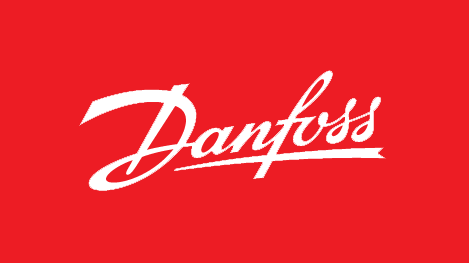Danfoss – Danfoss demonstrates the growth opportunities in competitive decarbonization
Powering European Industry: Competitive decarbonization can drive Europe’s industrial future
Danfoss, in collaboration with the International Energy Agency (IEA), BusinessEurope, and Danish Industry, hosted a major conference last week bringing together industry leaders and policymakers to address Europe’s competitiveness challenges.
See the video on YouTube
- More than 80 industry leaders and policy makers gathered in Sønderborg, Denmark for the Powering European Industry event last week.
- European competitiveness under pressure was the focus of the event, with participants discussing what can be done together and what’s needed from the new EU Commission.
- Danfoss President and CEO Kim Fausing argued that decarbonization isn’t just the right thing to do – it also brings down energy costs and increases our competitiveness.
Danfoss, in collaboration with the International Energy Agency (IEA), BusinessEurope, and Danish Industry, hosted a major conference last week bringing together industry leaders and policymakers to address Europe’s competitiveness challenges. The event, held in Sønderborg, focused on providing concrete input to the incoming European Commission’s planned Clean Industrial Deal.
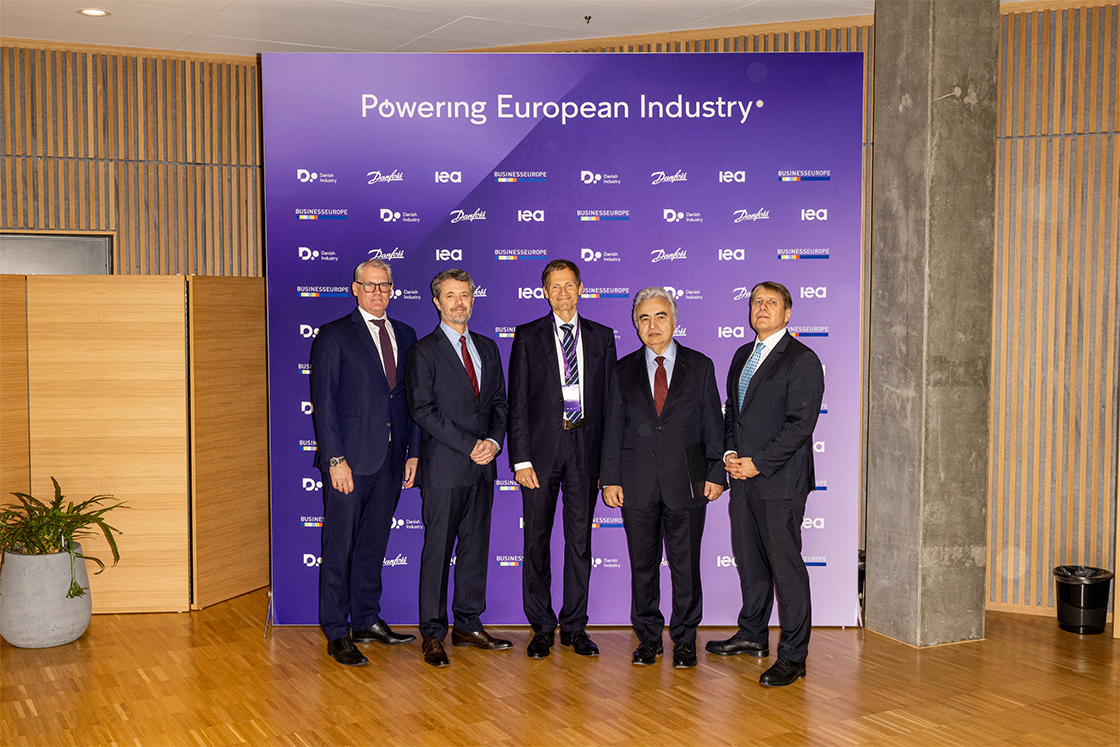
From left to right: Thomas Bustrup, Deputy Director General, Danish Industry, His Majesty King Frederik X of Denmark, Kim Fausing, President and CEO, Danfoss, Dr. Fatih Birol, Executive Director, International Energy Agency, Markus Beyrer, Director General, BusinessEurope.
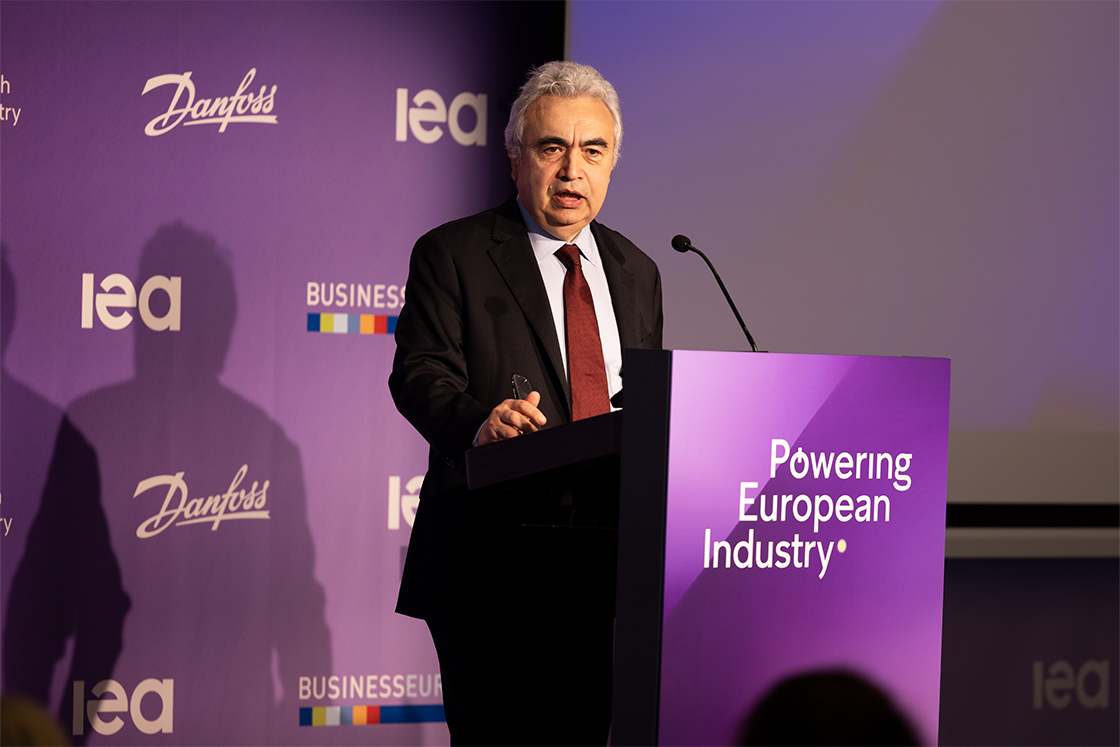
Dr. Fatih Birol, Executive Director, International Energy Agency, speaking at the Powering European Industry event.
The opening plenary session featured addresses from IEA Executive Director, Dr Fatih Birol, Danfoss President and CEO, Kim Fausing, and HM King Frederik X of Denmark, with each speech underscoring the critical need for competitiveness and the potential for Europe to lead in the age of electricity.
Dr Birol emphasized competitiveness as the top priority for the new EU Commission, saying: “I am worried that Europe will miss the train of being an important player in tomorrow’s modern industries.”
High energy costs, worsened by geopolitical events, continue to threaten European industries’ profitability and competitiveness. Dr Birol added: “If we leave everything to our usual policies, usual tools, usual instruments, I can tell you honestly that Europe will not be a major player in tomorrow’s clean energy technology. It will be an important player but not a leading one.”
Watch the opening speeches
Opening remarks from the Powering European Industry event in Sønderborg, 29 October 2024
See the video on YouTube
Kim Fausing underlined that competitive decarbonization is one of the solutions to the challenge of restoring European competitiveness, saying. “It could not only be the right thing to do, it could also be really driving Europe’s competitiveness. It can also drive a great growth opportunity.”
His comments support the findings of the latest Danfoss Impact paper which states that competitive decarbonization” holds the key to unlocking European competitiveness, enabling industries to simultaneously reduce their environmental footprint and enhance their competitive edge.The optimization of motor efficiency in the EU alone could save €9.5-10.7 billion in electricity costs annually while avoiding 12.5-14.1 million tons of CO2-emissions – equivalent to the annual footprint of up to two million European citizens.
Kim Fausing, who declared he is a stubborn optimist when it comes to Europe’s future, explained that the solutions are already available to drive energy efficiency and electrification – but we need more speed. He also referenced Mario Draghi’s report on the future of European Competitiveness, which states “decarbonization must become a source of growth”.
Closed-door roundtable, chaired by Kim Fausing and moderated by former EU Commissioner Connie Hedegaard, identified key challenges and solutions.
We need to get back to the entrepreneurial mindset in Europe where we believe in the future. We should be happy to invest in Europe because there is a reliable and long-term plan. And that’s not stop and go. We need what I’d call a masterplan, or a well-defined effective long-term regulation.
Kim Fausing, President and CEO, Danfoss
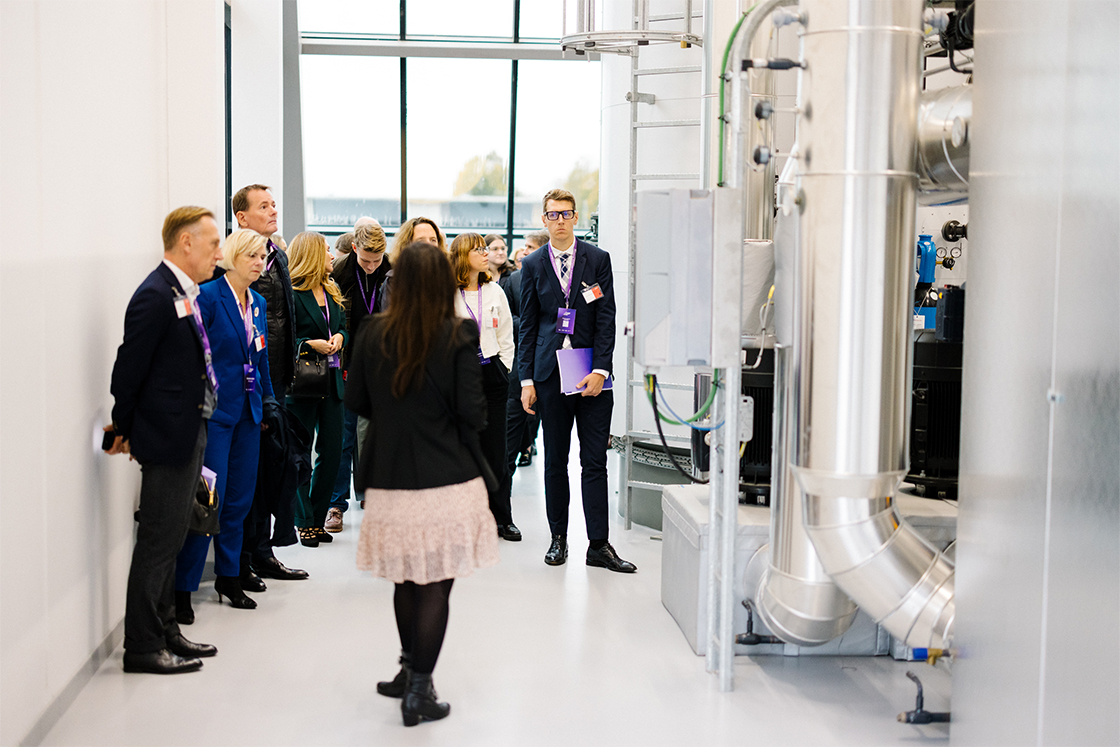
Site visits gave participants the opportunity to experience first-hand the solutions that can be implemented today.
The conference also included a closed-door roundtable, chaired by Kim Fausing and moderated by former EU Commissioner Connie Hedegaard, which identified key challenges and solutions. Participants emphasized the need for a more streamlined European energy policy, increased electrification, reduced bureaucracy, and better utilization of incentives, particularly for energy efficiency. The importance of leveraging AI and digitalization, differentiating energy price from cost, and ensuring long-term regulatory consistency for investment were also highlighted.
IEA Chief Economist Tim Gould presented findings from the World Energy Outlook, noting the impact of high energy prices on European competitiveness but also predicting a potential price decrease. This raised questions about whether policymakers would seize the opportunity to enact necessary reforms. Industry representatives from Vattenfall and Saint Gobain stressed the need for clear demand signals and improved access to affordable, clean energy.
Subsequent fireside chats and roundtable discussions explored innovation, financing, electrification, energy security, and the EU’s 2040 climate targets.
Site visits also gave conference participants the opportunity to experience first-hand the solutions that can be implemented today. The highly engaged participants visited both Danfoss’ carbon neutral headquarters in Nordborg and the Vesterled Brick Plant which is on track towards carbon neutrality.
Following the event, Danfoss will now be working with like-minded, progressive industry players to give the new EU Commission concrete input on what they can do to help put European industrial competitiveness back on track.
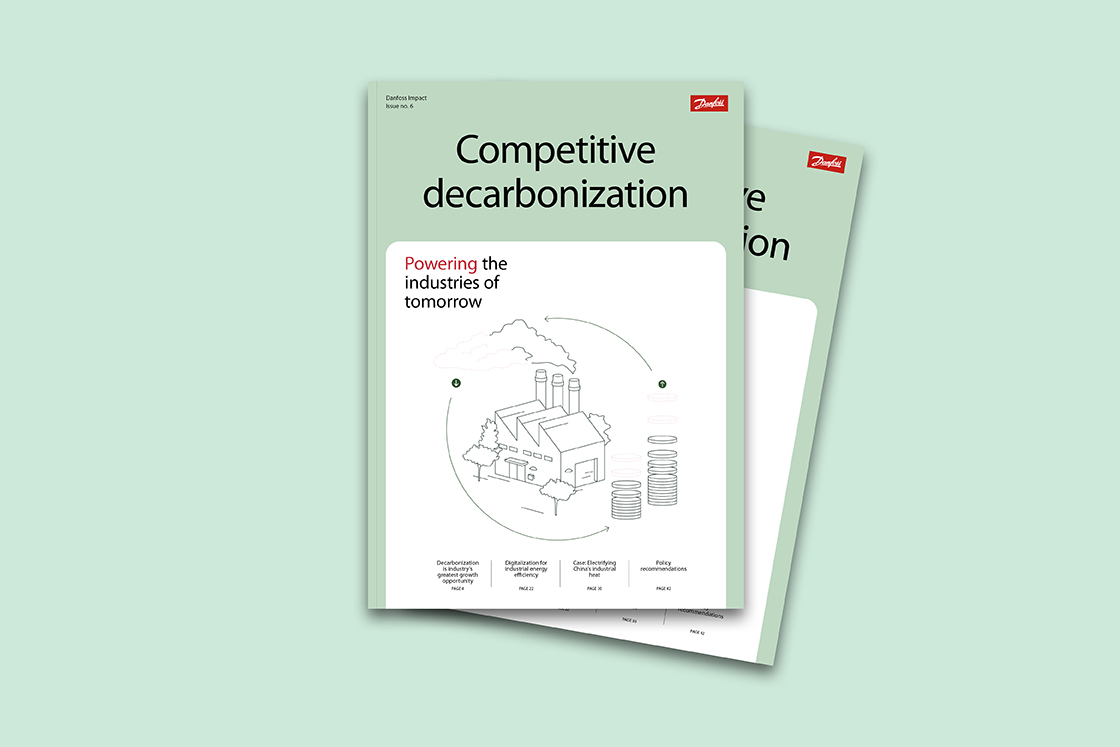
Competitive decarbonization: Powering the industries of tomorrow
Download the Danfoss Impact paper here
SourceDanfoss
EMR Analysis
More information on Danfoss: See the full profile on EMR Executive Services
More information on Kim Fausing (President and Chief Executive Officer, Danfoss): See the full profile on EMR Executive Services
More information on Powering European Industry Event (October 28-29 2024, Sønderborg, Denmark – Jointly hosted by Danish Industry, Danfoss, the International Energy Agency and BusinessEurope): https://www.danskindustri.dk/globalassets/brancher/di-energi/powering-european-energy/powering-european-industry—programme—extra.pdf?v=240706 + Powering European Industry, takes place over 24 hours on 28-29 October in Sønderborg, Denmark. It brings together leading European industry executives, policy makers, organizations and thought leaders to proactively address the twin challenges of European competitiveness and the clean energy transition at the center of a European industrial strategy.
More information on IEA (International Energy Agency): https://www.iea.org + The IEA is at the heart of global dialogue on energy, providing authoritative analysis, data, policy recommendations, and real-world solutions to help countries provide secure and sustainable energy for all.
The IEA was created in 1974 to help co-ordinate a collective response to major disruptions in the supply of oil. While oil security this remains a key aspect of our work, the IEA has evolved and expanded significantly since its foundation.
Taking an all-fuels, all-technology approach, the IEA recommends policies that enhance the reliability, affordability and sustainability of energy. It examines the full spectrum issues including renewables, oil, gas and coal supply and demand, energy efficiency, clean energy technologies, electricity systems and markets, access to energy, demand-side management, and much more.
Since 2015, the IEA has opened its doors to major emerging countries to expand its global impact, and deepen cooperation in energy security, data and statistics, energy policy analysis, energy efficiency, and the growing use of clean energy technologies.
More information on Dr. Fatih Birol (Executive Director, International Energy Agency): https://www.iea.org/contributors/dr-fatih-birol + https://www.linkedin.com/in/fatih-birol/
More information on Tim Gould (Chief Economist, International Energy Agency): https://www.iea.org/contributors/tim-gould + https://www.linkedin.com/in/tim-gould-95999aba/
More information on BusinessEurope: https://www.businesseurope.eu/ + BusinessEurope is the leading advocate for growth and competitiveness at European level, standing up for companies across the continent and actively campaigning on the issues that most influence their performance. We speak for enterprises of all sizes in 36 European countries whose national business federations are our direct members.
More information on Fredrik Persson (President, BusinessEurope): https://www.businesseurope.eu/history-organisation + https://commission.europa.eu/fredrik-persson_en + https://www.linkedin.com/in/fredrik-persson-b58330102/
More information on Markus J. Beyrer (Director General, BusinessEurope): https://www.businesseurope.eu/history-organisation + https://www.businesseurope.eu/departments
More information on Dansk Industri (DI): https://www.danskindustri.dk/english/ + DI is a private business and employers’ organisation representing approximately 20,000 companies in Denmark. We aim to provide the best possible corporate conditions for our member companies.
Danish Industry – DI – is Denmark’s largest, most representative and most influential business and employers’ organisation, covering manufacturing as well as service industries across sectors such as transport, energy, IT, health, trade and professional services.
More information on Lars Sandahl Sørensen (Chief Executive Officer, Dansk Industri (DI)): https://www.danskindustri.dk/english/about-di/organization/ + https://www.linkedin.com/in/lars-sandahl-sørensen-1768249/
More information on Thomas Bustrup (Deputy Director General, Dansk Industri (DI)): https://www.danskindustri.dk/english/about-di/organization/ + https://www.linkedin.com/in/thomas-bustrup-aa23903/
More information on The European Union: https://european-union.europa.eu/index_en + The European Union’s institutional set-up is unique and its decision-making system is constantly evolving. The 7 European institutions, 7 EU bodies and over 30 decentralised agencies are spread across the EU. They work together to address the common interests of the EU and European people.
In terms of administration, there are a further 20 EU agencies and organisations which carry out specific legal functions and 4 interinstitutional services which support the institutions.
All of these establishments have specific roles – from developing EU laws and policy-making to implementing policies and working on specialist areas, such as health, medicine, transport and the environment.
There are 4 main decision-making institutions which lead the EU’s administration. These institutions collectively provide the EU with policy direction and play different roles in the law-making process:
- the European Parliament (Brussels/Strasbourg/Luxembourg)
- the European Council (Brussels)
- the Council of the European Union (Brussels/Luxembourg)
- the European Commission (Brussels/Luxembourg/Representations across the EU)
Their work is complemented by other institutions and bodies, which include:
- the Court of Justice of the European Union (Luxembourg)
- the European Central Bank (Frankfurt)
- the European Court of Auditors (Luxembourg)
The EU institutions and bodies cooperate extensively with the network of EU agencies and organisations across the European Union. The primary function of these bodies and agencies is to translate policies into realities on the ground.
Around 60,000 EU civil servants and other staff serve the 450 million Europeans (and countless others around the world).
Currently, 27 countries are part of the EU: https://european-union.europa.eu/principles-countries-history/country-profiles_en
More information on The European Commission: https://ec.europa.eu/info/index_en + The Commission helps to shape the EU’s overall strategy, proposes new EU laws and policies, monitors their implementation and manages the EU budget. It also plays a significant role in supporting international development and delivering aid.
The Commission is steered by a group of 27 Commissioners, known as ‘the college’. Together they take decisions on the Commission’s political and strategic direction.
A new college of Commissioners is appointed every 5 years.
The Commission is organised into policy departments, known as Directorates-General (DGs), which are responsible for different policy areas. DGs develop, implement and manage EU policy, law, and funding programmes. In addition, service departments deal with particular administrative issues. Executive agencies manage programmes set up by the Commission.
Principal roles in law: The Commission proposes and implements laws which are in keeping with the objectives of the EU treaties. It encourages input from business and citizens in the law-making process and ensures laws are correctly implemented, evaluated and updated when needed.
More information on Ursula von der Leyen (President, The European Commission): https://ec.europa.eu/commission/commissioners/2019-2024/president_en + https://www.linkedin.com/in/ursula-von-der-leyen/
More information on The Green Deal Industrial Plan by the European Commission: https://commission.europa.eu/strategy-and-policy/priorities-2019-2024/european-green-deal/green-deal-industrial-plan_en + Putting Europe’s net-zero industry in the lead.
The Green Deal Industrial Plan enhances the competitiveness of Europe’s net-zero industry and is accelerating the transition to climate neutrality. It does so by creating a more supportive environment for scaling up the EU’s manufacturing capacity for the net-zero technologies and products required to meet Europe’s ambitious climate targets.
More information on His Majesty King Frederik X of Denmark: https://www.kongehuset.dk/en/the-royal-family/hm-the-king/#
More information on Mario Draghi (Italian economist, academic, banker, and civil servant who served as the prime minister of Italy from February 2021 to October 2022. Prior to his appointment as prime minister, he served as President of the European Central Bank between 2011 and 2019): https://commission.europa.eu/topics/strengthening-european-competitiveness/eu-competitiveness-looking-ahead_en
More information on Connie Hedegaard (Former EU Commissioner): https://conniehedegaard.com/ + https://ec.europa.eu/archives/commission_2010-2014/hedegaard/index_en.htm + https://www.linkedin.com/in/connie-hedegaard-1573282/
More information Vattenfall: https://group.vattenfall.com/ + Vattenfall’s main markets are Sweden, Germany, the Netherlands, Denmark, and the UK. The Vattenfall Group has approximately 19,000 employees.
Vattenfall is a leading European energy company, that for more than 100 years has electrified industries, supplied energy to people’s homes and modernised our way of living through innovation and cooperation. Our goal is fossil freedom. Therefore we are driving the transition to a more sustainable energy system through growth in renewable production and climate smart energy solutions for our customers.
The parent company of the Vattenfall Group, Vattenfall AB, is a non-listed company, 100 per cent owned by the Swedish state. Vattenfall finances its operations by own generated cash flow and external funding, mainly in the form of corporate bonds. Our long term credit ratings are BBB+ stable outlook by S&P and A3 stable outlook by Moody’s. Vattenfall has a committed Revolving Credit Facility of EUR 2 billion.
More information on Anna Borg (President & Chief Executive Officer, Vattenfall): https://group.vattenfall.com/who-we-are/corporate-governance/group-management/anna-borg + https://www.linkedin.com/in/annaborgvattenfall/
More information on Saint-Gobain: https://www.saint-gobain.com/en + Worldwide leader in light and sustainable construction, Saint-Gobain designs, manufactures and distributes materials and services for the construction and industrial markets. Its integrated solutions for the renovation of public and private buildings, light construction and the decarbonization of construction and industry are developed through a continuous innovation process and provide sustainability and performance. The Group’s commitment is guided by its purpose, “MAKING THE WORLD A BETTER HOME”.
- Sales figures: 47.9 billion euros in turnover in 2023
- Headcount: 160,000 employees
- International presence: Saint-Gobain is present in 76 countries
- Net Zero Carbon: Committed to achieving Carbon Neutrality by 2050
More information on Benoît Bazin (Chairman and Chief Executive Officer, Saint-Gobain): https://www.saint-gobain.com/en/group/corporate-governance/executive-committe + https://www.linkedin.com/in/benoit-bazin-60723b119/
EMR Additional Notes:
- Carbon Dioxide (CO2):
- Primary greenhouse gas emitted through human activities. Carbon dioxide enters the atmosphere through burning fossil fuels (coal, natural gas, and oil), solid waste, trees and other biological materials, and also as a result of certain chemical reactions (e.g., manufacture of cement). Carbon dioxide is removed from the atmosphere (or “sequestered”) when it is absorbed by plants as part of the biological carbon cycle.
- Biogenic Carbon Dioxide (CO2):
- Biogenic Carbon Dioxide (CO2) and Carbon Dioxide (CO2) are the same. Scientists differentiate between biogenic carbon (that which is absorbed, stored and emitted by organic matter like soil, trees, plants and grasses) and non-biogenic carbon (that found in all other sources, most notably in fossil fuels like oil, coal and gas).
- Decarbonization:
- Reduction of carbon dioxide emissions through the use of low carbon power sources, achieving a lower output of greenhouse gasses into the atmosphere.
- Carbon Footprint:
- There is no universally agreed definition of what a carbon footprint is.
- A carbon footprint is generally understood to be the total amount of greenhouse gas (GHG) emissions that are directly or indirectly caused by an individual, organization, product, or service. These emissions are typically measured in tonnes of carbon dioxide equivalent (CO2e).
- In 2009, the Greenhouse Gas Protocol (GHG Protocol) published a standard for calculating and reporting corporate carbon footprints. This standard is widely accepted by businesses and other organizations around the world. The GHG Protocol defines a carbon footprint as “the total set of greenhouse gas emissions caused by an organization, directly and indirectly, through its own operations and the value chain.”
- CO2e (Carbon Dioxide Equivalent):
- CO2e means “carbon dioxide equivalent”. In layman’s terms, CO2e is a measurement of the total greenhouse gases emitted, expressed in terms of the equivalent measurement of carbon dioxide. On the other hand, CO2 only measures carbon emissions and does not account for any other greenhouse gases.
- A carbon dioxide equivalent or CO2 equivalent, abbreviated as CO2-eq is a metric measure used to compare the emissions from various greenhouse gases on the basis of their global-warming potential (GWP), by converting amounts of other gases to the equivalent amount of carbon dioxide with the same global warming potential.
- Carbon dioxide equivalents are commonly expressed as million metric tonnes of carbon dioxide equivalents, abbreviated as MMTCDE.
- The carbon dioxide equivalent for a gas is derived by multiplying the tonnes of the gas by the associated GWP: MMTCDE = (million metric tonnes of a gas) * (GWP of the gas).
- For example, the GWP for methane is 25 and for nitrous oxide 298. This means that emissions of 1 million metric tonnes of methane and nitrous oxide respectively is equivalent to emissions of 25 and 298 million metric tonnes of carbon dioxide.
- Carbon Capture and Storage (CCS) – Carbon Capture, Utilisation and Storage (CCUS):
- CCS involves the capture of carbon dioxide (CO2) emissions from industrial processes. This carbon is then transported from where it was produced, via ship or in a pipeline, and stored deep underground in geological formations.
- CCS projects typically target 90 percent efficiency, meaning that 90 percent of the carbon dioxide from the power plant will be captured and stored.
- Carbon Dioxide Removal (CDR):
- Carbon Dioxide Removal encompasses approaches and methods for removing CO2 from the atmosphere and then storing it permanently in underground geological formations, in biomass, oceanic reservoirs or long-lived products in order to achieve negative emissions.
- Direct Air Capture (DAC):
- Technologies extracting CO2 directly from the atmosphere at any location, unlike carbon capture which is generally carried out at the point of emissions, such as a steel plant.
- Constraints like costs and energy requirements as well as the potential for pollution make DAC a less desirable option for CO2 reduction. Its larger land footprint when compared to other mitigation strategies like carbon capture and storage systems (CCS) also put it at a disadvantage.
- Carbon Credits or Carbon Offsets:
- Permits that allow the owner to emit a certain amount of carbon dioxide or other greenhouse gases. One credit permits the emission of one ton of carbon dioxide or the equivalent in other greenhouse gases.
- The carbon credit is half of a so-called cap-and-trade program. Companies that pollute are awarded credits that allow them to continue to pollute up to a certain limit, which is reduced periodically. Meanwhile, the company may sell any unneeded credits to another company that needs them. Private companies are thus doubly incentivized to reduce greenhouse emissions. First, they must spend money on extra credits if their emissions exceed the cap. Second, they can make money by reducing their emissions and selling their excess allowances.
- AI – Artificial Intelligence:
- https://searchenterpriseai.techtarget.com/definition/AI-Artificial-Intelligence +
- Artificial intelligence is the simulation of human intelligence processes by machines, especially computer systems.
- As the hype around AI has accelerated, vendors have been scrambling to promote how their products and services use AI. Often what they refer to as AI is simply one component of AI, such as machine learning. AI requires a foundation of specialized hardware and software for writing and training machine learning algorithms. No one programming language is synonymous with AI, but well a few, including Python, R and Java, are popular.
- In general, AI systems work by ingesting large amounts of labeled training data, analyzing the data for correlations and patterns, and using these patterns to make predictions about future states. In this way, a chatbot that is fed examples of text chats can learn to produce lifelike exchanges with people, or an image recognition tool can learn to identify and describe objects in images by reviewing millions of examples.
- AI programming focuses on three cognitive skills: learning, reasoning and self-correction.
- What are the 4 types of artificial intelligence?
- Type 1: Reactive machines. These AI systems have no memory and are task specific. An example is Deep Blue, the IBM chess program that beat Garry Kasparov in the 1990s. Deep Blue can identify pieces on the chessboard and make predictions, but because it has no memory, it cannot use past experiences to inform future ones.
- Type 2: Limited memory. These AI systems have memory, so they can use past experiences to inform future decisions. Some of the decision-making functions in self-driving cars are designed this way.
- Type 3: Theory of mind. Theory of mind is a psychology term. When applied to AI, it means that the system would have the social intelligence to understand emotions. This type of AI will be able to infer human intentions and predict behavior, a necessary skill for AI systems to become integral members of human teams.
- Type 4: Self-awareness. In this category, AI systems have a sense of self, which gives them consciousness. Machines with self-awareness understand their own current state. This type of AI does not yet exist.
- Machine Learning (ML):
- Developed to mimic human intelligence, it lets the machines learn independently by ingesting vast amounts of data, statistics formulas and detecting patterns.
- ML allows software applications to become more accurate at predicting outcomes without being explicitly programmed to do so.
- ML algorithms use historical data as input to predict new output values.
- Recommendation engines are a common use case for ML. Other uses include fraud detection, spam filtering, business process automation (BPA) and predictive maintenance.
- Classical ML is often categorized by how an algorithm learns to become more accurate in its predictions. There are four basic approaches: supervised learning, unsupervised learning, semi-supervised learning and reinforcement learning.
- Deep Learning (DL):
- Subset of machine learning, Deep Learning enabled much smarter results than were originally possible with ML. Face recognition is a good example.
- DL makes use of layers of information processing, each gradually learning more and more complex representations of data. The early layers may learn about colors, the next ones about shapes, the following about combinations of those shapes, and finally actual objects. DL demonstrated a breakthrough in object recognition.
- DL is currently the most sophisticated AI architecture we have developed.
- Computer Vision (CV):
- Computer vision is a field of artificial intelligence that enables computers and systems to derive meaningful information from digital images, videos and other visual inputs — and take actions or make recommendations based on that information.
- The most well-known case of this today is Google’s Translate, which can take an image of anything — from menus to signboards — and convert it into text that the program then translates into the user’s native language.
- Machine Vision (MV):
- Machine Vision is the ability of a computer to see; it employs one or more video cameras, analog-to-digital conversion and digital signal processing. The resulting data goes to a computer or robot controller. Machine Vision is similar in complexity to Voice Recognition.
- MV uses the latest AI technologies to give industrial equipment the ability to see and analyze tasks in smart manufacturing, quality control, and worker safety.
- Computer Vision systems can gain valuable information from images, videos, and other visuals, whereas Machine Vision systems rely on the image captured by the system’s camera. Another difference is that Computer Vision systems are commonly used to extract and use as much data as possible about an object.
- Generative AI (GenAI):
- Generative AI technology generates outputs based on some kind of input – often a prompt supplied by a person. Some GenAI tools work in one medium, such as turning text inputs into text outputs, for example. With the public release of ChatGPT in late November 2022, the world at large was introduced to an AI app capable of creating text that sounded more authentic and less artificial than any previous generation of computer-crafted text.
- https://searchenterpriseai.techtarget.com/definition/AI-Artificial-Intelligence +
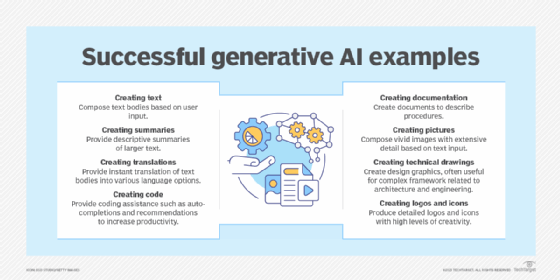
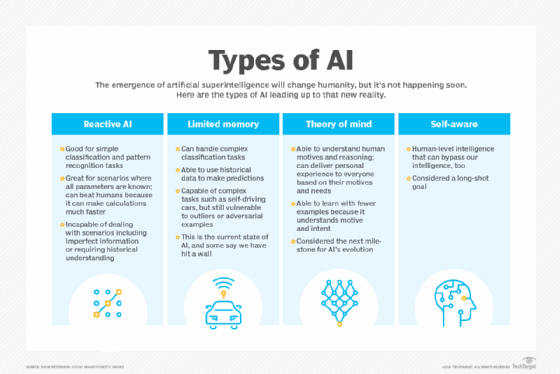
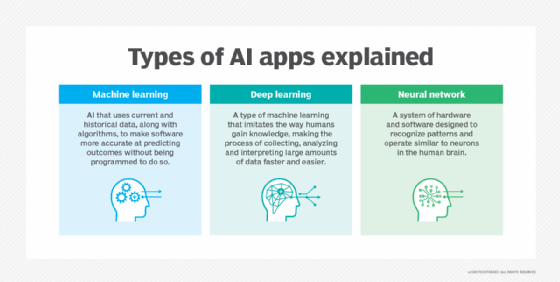
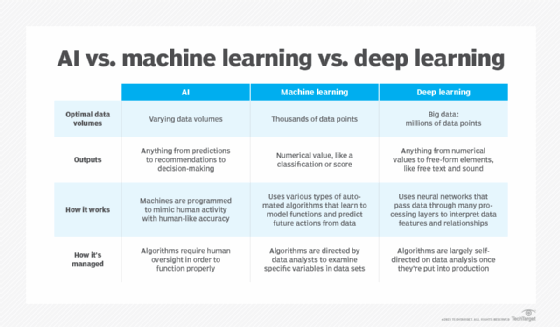
- Edge AI Technology:
- Edge artificial intelligence refers to the deployment of AI algorithms and AI models directly on local edge devices such as sensors or Internet of Things (IoT) devices, which enables real-time data processing and analysis without constant reliance on cloud infrastructure.
- Simply stated, edge AI, or “AI on the edge“, refers to the combination of edge computing and artificial intelligence to execute machine learning tasks directly on interconnected edge devices. Edge computing allows for data to be stored close to the device location, and AI algorithms enable the data to be processed right on the network edge, with or without an internet connection. This facilitates the processing of data within milliseconds, providing real-time feedback.
- Self-driving cars, wearable devices, security cameras, and smart home appliances are among the technologies that leverage edge AI capabilities to promptly deliver users with real-time information when it is most essential.
- Multimodal Intelligence and Agents:
- Subset of artificial intelligence that integrates information from various modalities, such as text, images, audio, and video, to build more accurate and comprehensive AI models.
- Multimodal capabilities allows to interact with users in a more natural and intuitive way. It can see, hear and speak, which means that users can provide input and receive responses in a variety of ways.
- An AI agent is a computational entity designed to act independently. It performs specific tasks autonomously by making decisions based on its environment, inputs, and a predefined goal. What separates an AI agent from an AI model is the ability to act. There are many different kinds of agents such as reactive agents and proactive agents. Agents can also act in fixed and dynamic environments. Additionally, more sophisticated applications of agents involve utilizing agents to handle data in various formats, known as multimodal agents and deploying multiple agents to tackle complex problems.

